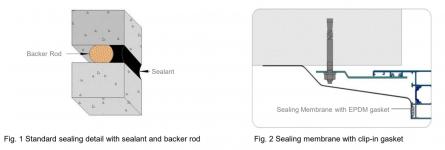From a conceptual point of view, we are trying to give continuity regarding water tightness, between one system, that in our taxonomy would fit on the upper rows, and another which would fit on the bottom row.
Overlapped watertightness strategies (142)
Overlapped watertightness strategies (142)
A few days ago, one of my students asked a question regarding water-tightness – ‘ why do we place a membrane all around the perimeter of the openings in the rain screen façade, while in the panel façade a sealing seems to be enough’. The question is extremely relevant and is directly linked to the particular scheme of classification.
When we build a façade, we need to give continuity to the different functions the façade must fulfil even though the constructional solutions or the systems being used, may be different. Thermal behaviour, water and air tightness, acoustic performance and mechanical continuity, among others, need to be achieved in the façade as a whole and in each of its parts. Ensuring the continuity of these functions across these systems is a design challenge the architect must resolve.
In the specific case that the student was referring to regarding water-tightness, we observe that, we not only need to provide continuity to fulfil this function, but we also need to solve the fact that the window and the rain screen façade resolve this function using different strategies.
While the window uses glass, frames and the gaskets between them, to ensure water tightness through creating a material barrier, the rain screen façade entrusts its water-tightness to drainage. In the façade panel this does not happen: all the systems, both window and panel, entrust water-tightness to a material barrier and so to create continuity between them requires no more than sealing the joints between them. When the strategy between systems changes, the specific joint to be sealed does not exist and so we need to find a mechanism that enables them to be overlapped. The membrane providess this mechanism: a thin and flexile water tight material that is fitted within the drainage cavity over the length required to overlap the two different strategies.

